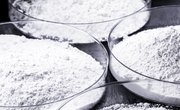The water that is used in homes, businesses and industries is often treated through a chemical process to remove harmful substances and bacteria. Once the water has been chemically treated, it can be safely recycled back into the water source. Several different chemicals can be used to treat water, such as chlorine, lime and hydrogen peroxide. Each method offers distinct advantages and disadvantages for use in water treatment.
Chlorine
According to the Water Quality and Health Council, prior to the use of chlorinated drinking water at the turn of the century, waterborne diseases such as cholera, typhoid fever, dysentery and hepatitis claimed thousands of U.S. lives each year. Today, chlorination is still the most common disinfection method for public drinking water and swimming pools. Not only does chlorination help prevent the spread of infections such as E. coli, it also destroys bacteria, algae and mold that can grow on the walls of water storage systems, and it removes unpleasant tastes and odors from drinking water. While chlorination is effective at sanitizing drinking water, it can be difficult to handle without expertise and experience. The chlorination of water used for showering, laundering and swimming can dry out the skin and hair, may cause eye irritation and can also fade fabrics.
Lime
Hard water contains high levels of dissolved minerals, which can build up in water pipes and internal systems to cause obstruction and permanent damage. Water softeners made with hydrated lime can treat water quality to improve hard water and also reduce the levels of toxic arsenic in drinking water. Lime also alters the water pH and works to destroy the environment required for the growth of bacteria and viruses. In some cases, the pH levels become too high with lime softening. When lime is added to chlorinated water, the resulting formation of hypochlorite is a disinfectant that's inferior to other free chlorine residuals.
Hydrogen Peroxide
Hydrogen peroxide is a bleaching agent that can be used to whiten teeth, lighten hair, and bleach fabrics and textiles. It can also be used to disinfect water by removing pollutants and inhibiting the growth of bacterial agents. Hydrogen peroxide is generally considered safe, it does not produce residue or gas, and it can be used to remove chlorine residue left behind from chlorination. The substance must be transported and handled with care, since contact with hydrogen peroxide can cause irritation of the eyes, skin, lungs and mucous membranes. In addition, Lenntech notes that studies conducted by the American International Agency on Cancer Research indicate high-level exposure to hydrogen peroxide can be carcinogenic to animals.
References
About the Author
Sara Melone is a mother of three and a graduate of UNH. With prior careers in insurance and finance, photography, as well as certifications in fitness and nutrition, Melone draws directly from past experience and varying interests. She contributes with equal passion to birth journals, investment blogs, and self-help websites.
